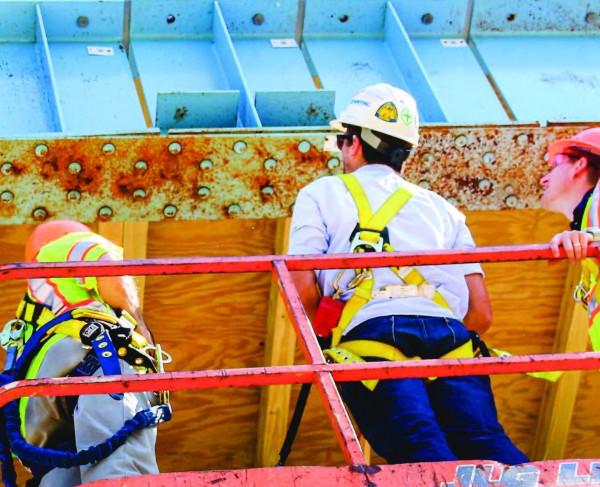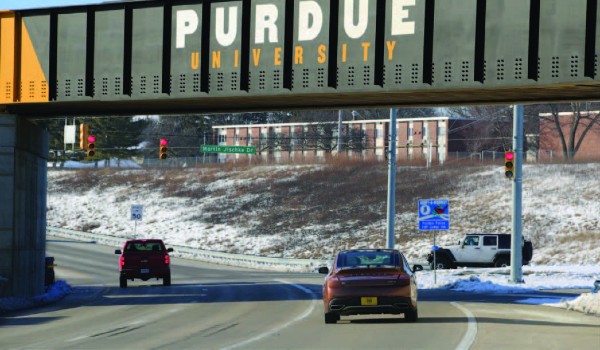Addressing America's Aging Infrastructure

Collaboration with researchers, government, and industry key to improving the country's roads, bridges
The American Society of Civil Engineers released its quadrennial report card on country’s infrastructure in April. The report card assesses 17 areas of infrastructure, assigning an overall grade of C-. That’s up from a D+ in 2017 and marks the first time the score was higher than a D since the ASCE began issuing its report card in 1998. It’s an indication that the nation is headed in the right direction, but more work remains.
There are more than 4 million miles of public roadways across the United States carrying people and goods to their destinations every day. However, an ever-increasing volume of traffic leads to wear and tear and 43% of the nation’s public roadways are classified as poor or mediocre condition.
“The interstate highway system was built in the 60s and 70s so we are reaching the end of that life cycle,” said Darcy Bullock, Lyles Family Professor of Civil Engineering. “A key part of what we’re focused on at Purdue is how to maintain our aging infrastructure and use the connected vehicle data available to make smart investments in infrastructure that address the most urgent priorities.”
The Crossroads of America
Indiana is recognized as a leader among the states, thanks to a commitment to invest in infrastructure that began when University President Mitch Daniels was governor. In 2005, Daniels launched “Major Moves,” an aggressive 10-year transportation plan to significantly improve and expand the state’s infrastructure. As current Indiana Governor Eric Holcomb states, “For Indiana, ‘Crossroads of America’ is more than a motto, it’s a mission.”
The state ranked No. 3 in the country for infrastructure on CNBC’s annual America’s Top States for Business study, released in July 2021. Many innovations in the improvement, planning, construction and maintenance of infrastructure in Indiana emerge from the Joint Transportation Research Program at Purdue, which facilitates collaboration between the Indiana Department of Transportation (INDOT), higher education institutions and industry.
“More than $650 billion worth of freight moves through or from Indiana every year,” said Bullock, director of the Joint Transportation Research Program. “It is pretty important for our state to maintain high quality infrastructure and also to plan for the next generation of vehicles, including electric cars and connected autonomous vehicles.”
A recent study by the Joint Transportation Research Program and Ford Motor Company examined how the quality of pavement markings (i.e. painted lanes) affect vehicles equipped with advanced safety features such as lane keep assist. The findings were published in the journal Sensors in September.
“Our findings illustrate how something as seemingly simple as paint on the road is critical to the safety of roadways,” Bullock said. “A vehicle equipped with lane keep assist won’t be effective if the sensors cannot detect the lane markings. Not only do well-marked roadways improve the visibility of lanes for high tech cars, they also help human drivers see better particularly at night or in inclement weather.”
Identifying areas where road markings have deteriorated has been a time-consuming process where crews drive the roads and visually inspect the pavement. Now, data can be gathered from connected vehicles traveling on the roads to easily pinpoint where problem conditions exist.
“For the last 100 years, the automotive industry has built cars and civil engineers have built roads, but the two didn’t interface,” Bullock said. “Integrating our disciplines to plan for the future of transportation and infrastructure opens up a whole new frontier for civil engineering. Every time you go over a pothole, your vehicle knows it. As the number of connected vehicles on the road continues to grow, data about road conditions will be increasingly leveraged for infrastructure assessment.”

Instrumented Ford vehicle (at right) used to populate database for roadway infrastructure condition maps.
Meeting the Challenge
Another key finding in the ASCE report card on infrastructure concerns bridges. There are about 617,000 bridges in the U.S., 42% of which are at least 50 years old. About 8% of them are considered structurally deficient. According to the American Road and Transportation Builder’s Association 2020 Bridge Report, 178 million trips are taken across these structurally deficient bridges every day.
When some of those bridge components are rebuilt and replaced, the aging structures are relocated to the Steel Bridge Research, Inspection, Training and Engineering Center (S-BRITE) at Purdue. The first resident center of the Center for Aging Infrastructure (CAI), S-BRITE boasts three full-scale bridges and several sections of bridges taken from service.
“It is very beneficial for civil engineers to examine an actual specimen to understand what a certain type of corrosion looks like or how cracks occur and how to fix them,” said Rob Connor, the Jack and Kay Hockema Professor of Civil Engineering and director of CAI and S-BRITE. “You can look at pictures and do the calculations, but touching a physical structure gives students a tactile opportunity that leads to greater understanding.”
The multi-acre bridge component gallery at S-BRITE is the first of its kind for the steel bridge industry. Professional engineers and inspectors from around the country visit the center for hands-on training to identify fatigue cracks and other bridge stressors. Connor envisions a future role for the center to train dedicated infrastructure technicians, much like an appliance technician might receive training and certification from a trade school, except no such program exists for the bridge industry.
“As the design of structures gets more complex and existing bridges continue to age, the issues we encounter are more and more challenging and require specialized knowledge,” Connor said. “The development of a cooperative program for bridge technicians in collaboration with a technical school or a dedicated bridge engineering track within civil engineering makes sense for Purdue because we are a leader in this field. We have the knowledge base to positively impact the future of infrastructure across the country.”
